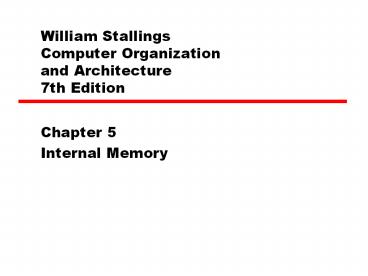William Stallings Computer Organization and Architecture 7th Edition - PowerPoint PPT Presentation
Title:
William Stallings Computer Organization and Architecture 7th Edition
Description:
Since SDRAM moves data in time with system clock, CPU knows when data will be ready ... Burst mode allows SDRAM to set up stream of data and fire it out in block ... – PowerPoint PPT presentation
Number of Views:66
Avg rating:3.0/5.0
Title: William Stallings Computer Organization and Architecture 7th Edition
1
William Stallings Computer Organization and
Architecture7th Edition
- Chapter 5
- Internal Memory
2
Semiconductor Memory Types
3
Semiconductor Memory
- RAM
- Misnamed as all semiconductor memory is random
access - Read/Write
- Volatile
- Temporary storage
- Static or dynamic
4
Memory Cell Operation
5
Dynamic RAM
- Bits stored as charge in capacitors
- Charges leak
- Need refreshing even when powered
- Simpler construction
- Smaller per bit
- Less expensive
- Need refresh circuits
- Slower
- Main memory
- Essentially analogue
- Level of charge determines value
6
Dynamic RAM Structure
7
DRAM Operation
- Address line active when bit read or written
- Transistor switch closed (current flows)
- Write
- Voltage to bit line
- High for 1 low for 0
- Then signal address line
- Transfers charge to capacitor
- Read
- Address line selected
- transistor turns on
- Charge from capacitor fed via bit line to sense
amplifier - Compares with reference value to determine 0 or 1
- Capacitor charge must be restored
8
Static RAM
- Bits stored as on/off switches
- No charges to leak
- No refreshing needed when powered
- More complex construction
- Larger per bit
- More expensive
- Does not need refresh circuits
- Faster
- Cache
- Digital
- Uses flip-flops
9
Stating RAM Structure
10
Static RAM Operation
- Transistor arrangement gives stable logic state
- State 1
- C1 high, C2 low
- T1 T4 off, T2 T3 on
- State 0
- C2 high, C1 low
- T2 T3 off, T1 T4 on
- Address line transistors T5 T6 is switch
- Write apply value to B compliment to B
- Read value is on line B
11
SRAM v DRAM
- Both volatile
- Power needed to preserve data
- Dynamic cell
- Simpler to build, smaller
- More dense
- Less expensive
- Needs refresh
- Larger memory units
- Static
- Faster
- Cache
12
Read Only Memory (ROM)
- Permanent storage
- Nonvolatile
- Microprogramming (see later)
- Library subroutines
- Systems programs (BIOS)
- Function tables
13
Types of ROM
- Written during manufacture
- Very expensive for small runs
- Programmable (once)
- PROM
- Needs special equipment to program
- Read mostly
- Erasable Programmable (EPROM)
- Erased by UV
- Electrically Erasable (EEPROM)
- Takes much longer to write than read
- Flash memory
- Erase whole memory electrically
14
Organisation in detail
- A 16Mbit chip can be organised as 1M of 16 bit
words - A bit per chip system has 16 lots of 1Mbit chip
with bit 1 of each word in chip 1 and so on - A 16Mbit chip can be organised as a 2048 x 2048 x
4bit array - Reduces number of address pins
- Multiplex row address and column address
- 11 pins to address (2112048)
- Adding one more pin doubles range of values so x4
capacity
15
Refreshing
- Refresh circuit included on chip
- Disable chip
- Count through rows
- Read Write back
- Takes time
- Slows down apparent performance
16
Typical 16 Mb DRAM (4M x 4)
17
Typical Memory Package Pins and Signals
18
256kByte MemoryOrganization
19
1MByte Module Organisation
20
Error Correction
- Hard Failure
- Permanent defect
- Soft Error
- Random, non-destructive
- No permanent damage to memory
- Detected using Hamming error correcting code
21
Error Correcting Code Function
22
Hamming Error-Correcting Code
23
Increase in Word Length with Error Correction
24
Layout of Data Bits and Check Bits
25
Chcek Bit Calculation
26
Hamming SEC-DEC Code
27
Advanced DRAM Organization
- Basic DRAM same since first RAM chips
- Enhanced DRAM
- Contains small SRAM as well
- SRAM holds last line read (c.f. Cache!)
- Cache DRAM
- Larger SRAM component
- Use as cache or serial buffer
28
Performance Comparison of Some DRAM Alternatives
29
Synchronous DRAM (SDRAM)
- Access is synchronized with an external clock
- Address is presented to RAM
- RAM finds data (CPU waits in conventional DRAM)
- Since SDRAM moves data in time with system clock,
CPU knows when data will be ready - CPU does not have to wait, it can do something
else - Burst mode allows SDRAM to set up stream of data
and fire it out in block - DDR-SDRAM sends data twice per clock cycle
(leading trailing edge)
30
SDRAM
31
SDRAM Pin Assignments
32
SDRAM Read Timing
33
RAMBUS
- Adopted by Intel for Pentium Itanium
- Main competitor to SDRAM
- Vertical package all pins on one side
- Data exchange over 28 wires lt cm long
- Bus addresses up to 320 RDRAM chips at 1.6Gbps
- Asynchronous block protocol
- 480ns access time
- Then 1.6 Gbps
34
RAMBUS Diagram
35
DDR SDRAM Road Timing
36
DDR SDRAM
- SDRAM can only send data once per clock
- Double-data-rate SDRAM can send data twice per
clock cycle - Rising edge and falling edge
37
Cache DRAM
- Mitsubishi
- Integrates small SRAM cache (16 kb) onto generic
DRAM chip - Used as true cache
- 64-bit lines
- Effective for ordinary random access
- To support serial access of block of data
- E.g. refresh bit-mapped screen
- CDRAM can prefetch data from DRAM into SRAM
buffer - Subsequent accesses solely to SRAM
38
Reading
- The RAM Guide
- RDRAM































